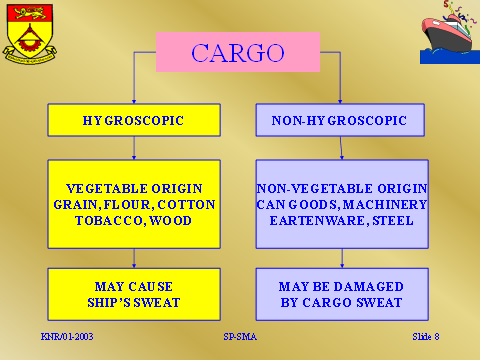Cargoes are mainly of two kinds
- Hygroscopic
- Hygroscopic cargoes are mainly of vegetable origin such as grain, flour, cotton, tobacco, wood and the like, all of which are affected by the humidity of the atmosphere, attracting, retaining and giving off moisture.
Hygroscopic cargoes cause ship’s sweat by virtue of changes in temperature, particularly when passing from warm areas to cooler conditions. More prevalent with sudden falls in outside temperature.
Hygroscopic cargoes:
- Cold to warm voyage
- Not critical, therefore ventilation not essential. On opening hatches at destination immediate condensation may form a surface but will dry off when cargo is discharged.
- Warm to cold voyage
Highly critical (eg. tropical produce en route to U.K.). Ventilation should be as vigorous as possible during the early stages but eventually the outside dew paint will be too low. This is most difficult voyage situation in which to arrange satisfactory ventilation
Non-hygroscopic :
- Non-hygroscopic cargoes are mainly of solid nature, such as steel products, machinery, earthenware, canned goods and the like, which can be subjected to damage from cargo sweat (condensation) in the form of rusting, staining and discolouration.
- More prevalent if loading has taken place in cold climates and the cargo later subjected to warm climatic conditions, when internal condensation is likely to be more applicable.
Temperature changes in the cargo need not be more than one or two degrees a day to activate sweat, irrespective of larger outside temperature fluctuations. When passing from cold to warm region it may be advisable to seal off ventilators in order to avoid problems of sweat which may arise.
Non-hygroscopic cargoes :
- Cold to warm voyage
- No ventilation; cargo sweat would occur on the surface of the stow if relatively warmer moisture laden air was admitted. Ex ….. steel exports U.K. to tropical ports.
- Warm to cold voyages
- Ship sweat inevitable but cargo unaffected unless condensation drips back on to the stow. It is emphasized that the above guidelines are only basic. The proximity of both types of cargo in the same space will cause modifications to achieve a satisfactory balance of ventilation effectiveness.


Leave a Comment